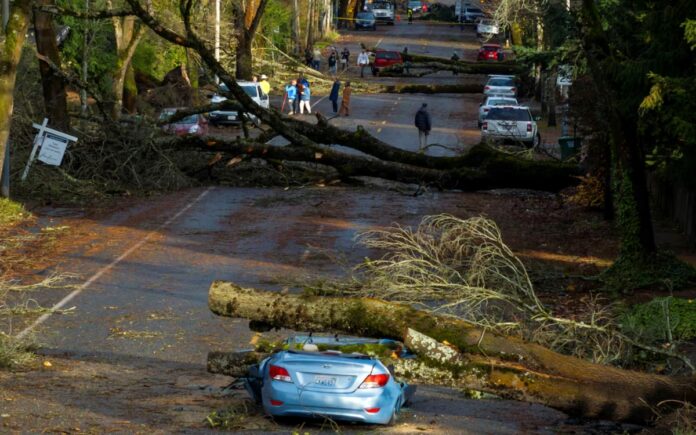Washington: A powerful atmospheric river storm battered Washington state on Wednesday, knocking out power to hundreds of thousands, disrupting road travel, and resulting in at least two fatalities and two injuries. The storm, the first of the season, brought tropical-storm-force winds and heavy rainfall, causing widespread damage before moving toward California, where it is expected to bring more extreme weather.
On Tuesday, a woman died after a tree fell on a homeless encampment in Lynnwood, north of Seattle. Another woman was killed near Seattle when a tree fell on her home, and two people were injured in Maple Valley, southeast of Seattle, when a tree struck their trailer.
The storm, which featured sustained winds of 50 mph (80 km/h) and gusts of up to 70 mph (110 km/h), downed trees and power lines, leaving more than 300,000 homes and businesses without power across Washington, Oregon, and Northern California by Wednesday night. At the storm’s peak, nearly 600,000 people were without electricity.
The storm also impacted British Columbia, Canada, where about 225,000 people lost power Tuesday night. By Wednesday evening, roughly 64,000 remained without power, mainly on Vancouver Island, according to BC Hydro.
Images broadcast by an NBC affiliate in Seattle showed cars crushed by fallen trees and homes severely damaged. In Bellevue, local officials posted on social media, urging residents to stay inside as trees continued to fall across the city.
The storm prompted the Snohomish Regional Fire & Rescue service to advise residents to remain at home, with widespread damage to power lines and trees. Schools throughout western Washington canceled or delayed classes due to the storm’s impacts.
Also Read | US Arrests Homeless Man in Plot to Bomb the New York Stock Exchange
The heavy weather system also caused significant disruptions in transportation, with snowfall shutting down Interstate 5 at the California-Oregon border. By Wednesday, heavy rain and snow were moving toward California, where the storm is forecast to continue causing life-threatening flooding along coastal northwest California and increase the likelihood of rock slides and debris flows.
Also Read | US Senate Overwhelmingly Votes to Approve Military Sales to Israel Amid Gaza Crisis
The storm, classified as a “bomb cyclone”, rapidly intensified, a process known as bombogenesis, when cold air from the polar region collided with warm tropical air. The National Weather Service predicts rainfall totals could reach 12 to 16 inches (300 to 400 mm) by Friday, with up to three feet (1 meter) of snow expected in the mountains. Wind gusts of up to 65 mph (100 km/h) could also accompany the snow, further complicating the already hazardous conditions.



